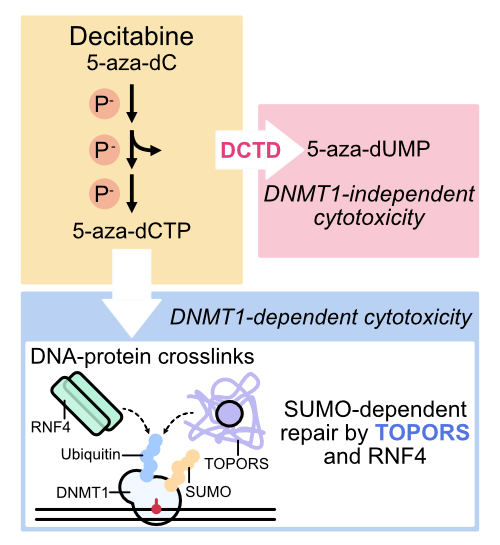DNA repair
The nucleoside analog decitabine's cytotoxicity: DCTD boosts, TOPORS prevents
17.05.2024
Abstract:
The nucleoside analog decitabine (or 5-aza-dC) is used to treat several hematological cancers. Upon its triphosphorylation and incorporation into DNA, 5-aza-dC induces covalent DNA methyltransferase 1 DNA-protein crosslinks, leading to DNA hypomethylation. However, 5-aza dC’s clinical outcomes vary, and relapse is common. Using genome-scale CRISPR/Cas9 screens, we map factors determining 5-aza-dC sensitivity. Unexpectedly, we find that loss of the dCMP deaminase DCTD causes 5-aza-dC resistance, suggesting that 5-aza-dUMP generation is cytotoxic. Combining results from a subsequent genetic screen in DCTD-deficient cells with identification of the DNMT1-DPC-proximal proteome, we uncover the ubiquitin and SUMO1 E3 ligase, TOPORS, as a new DPC repair factor. TOPORS is recruited to SUMOylated DNMT1- DPCs and promotes their degradation. Our study suggests that 5-aza-dC-induced DPCs cause cytotoxicity when DPC repair is compromised, while cytotoxicity in wild-type cells arises from perturbed nucleotide metabolism, potentially laying the foundations for future identification of predictive biomarkers for decitabine treatment.

Figure: Synopsis. DCTD and TOPORS modulate distinct modes of decitabine cytotoxicity. Source: EMBO Journal 2024
Original Publication:
Decitabine cytotoxicity is promoted by dCMP deaminase DCTD and mitigated by SUMO dependent E3 ligase TOPORS
Carnie CJ, Götz MJ, Palma-Chaundler CS, Weickert P, Wanders A, Serrano-Benitez A, Li H, Gupta V, Awwad SW, Blum CJ, Sczaniecka-Clift M, Cordes J, Zagnoli-Vieira G, D’Alessandro G, Richards SL, Gueorguieva N, Lam S, Beli P, Stingele J, Jackson SP.
EMBO Journal. 2024 May; https://doi.org/10.1038/s44318-024-00108-2

